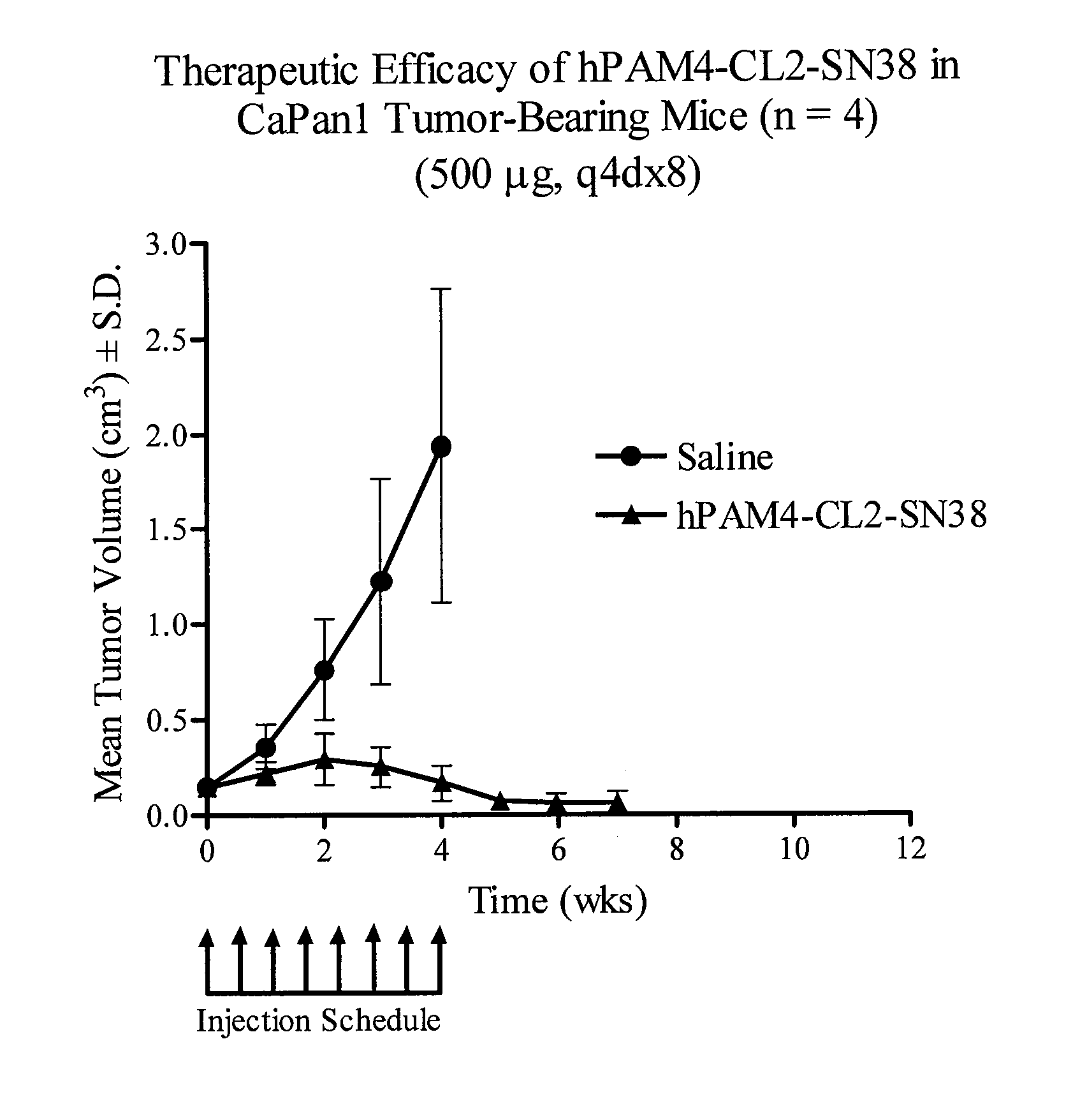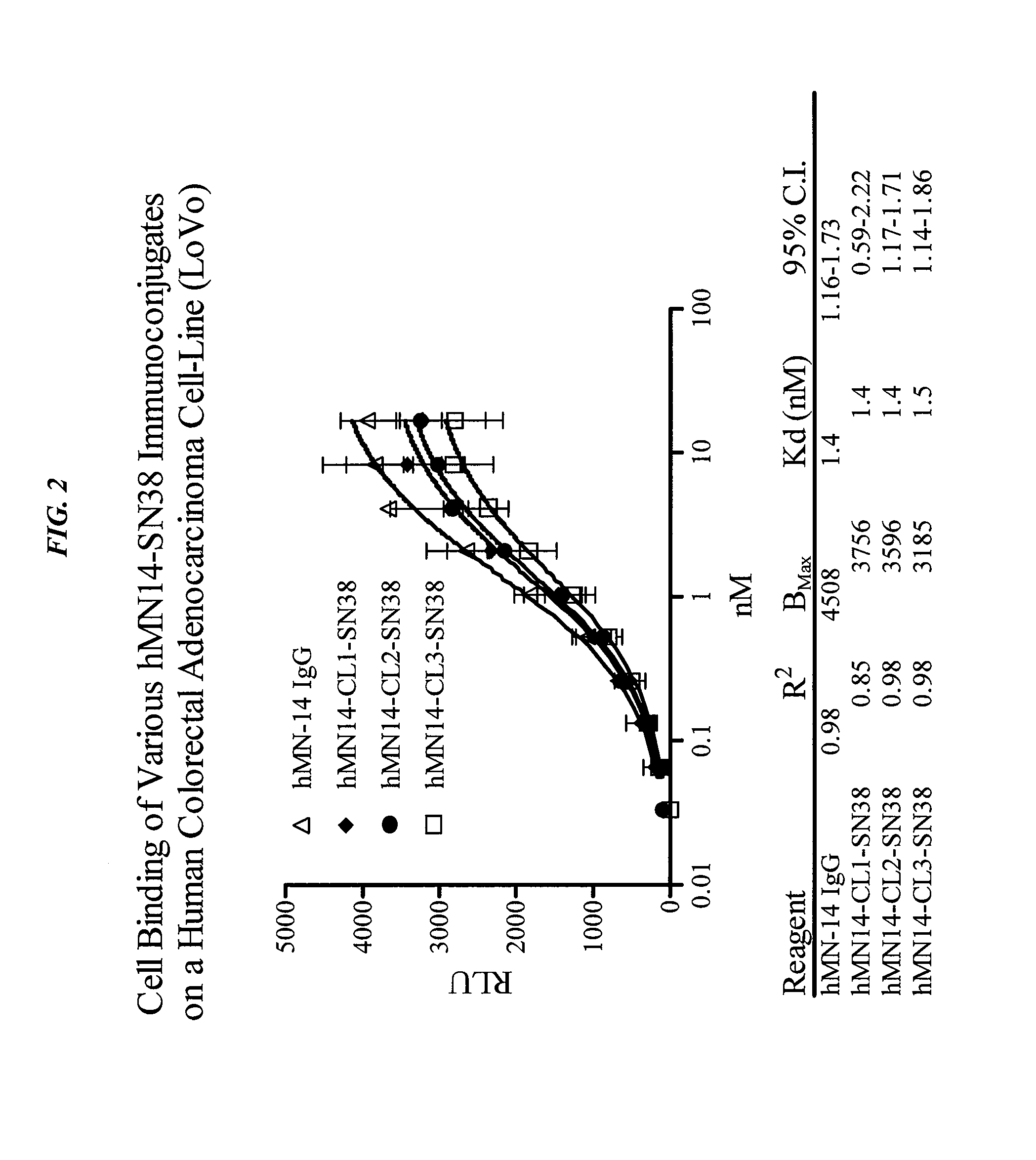Camptothecin-Binding Moiety Conjugates
a moiety conjugate and camptothecin technology, applied in the field of therapeutic conjugates, can solve the problems of reduced antitumor potency of these products, no application in other diseases, mixed success in cancer therapy, etc., and achieve the effect of reducing the course of therapy required and reducing certain severe side effects
- Summary
- Abstract
- Description
- Claims
- Application Information
AI Technical Summary
Benefits of technology
Problems solved by technology
Method used
Image
Examples
example 1
Preparation of CL1-SN-38
[0121]CL1-SN-38 is represented in Scheme-1. The azide precursor of CL1-SN-38 shown in the scheme has been described in the U.S. patent application corresponding to provisional U.S. Patent Application Ser. No. 60 / 885,325, filed on Jan. 17, 2007, the entire text of which is incorporated herein by reference. The reagent, namely 4-(N-maleimidomethyl)-N-(2-propynyl)cyclohexane-1-carboxamide, was prepared by reacting 0.107 g of SMCC and 0.021 mL of proparylamine (0.018 g; 1.01 equiv.) in dichloromethane using 1.1 equiv. of diisopropylethylamine. After 1 hr, the solvent was removed and the product was passed through a column of silica gel and eluted with 80:20 mixture of ethylacetate-hexane to obtain 83 mg of the product (colorless powder). Electrospray mass spectrum showed peaks at m / e 275 (M+H) and a base peak at m / e 192 in the positive ion mode, consistent with the structure calculated for C15H18N2O3: 275.1390 (M+H), found: 275.1394 (exact mass). A solution of th...
example 2
Preparation of CL2-SN-38
[0122]Synthesis is schematically shown in Scheme-2. The azide precursor of CL2-SN-38 shown in the scheme has been described in the U.S. patent application corresponding to provisional U.S. Patent Application Ser. No. 60 / 885,325, filed on Jan. 17, 2007, the entire text of which is incorporated herein by reference. The ‘click chemistry’ coupling of the azide precursor shown below with the acetylenic product described in Example 1 was carried out as follows. The azide (0.22 g, 0.127 mmol) and the acetylenic reagent (0.105 g, 0.38 mmol) were mixed in 3 mL of DMSO and 0.8 mL of water. Solid cuprous bromide (0.036 g, 2 equiv.) was added, and the heterogeneous mixture was stirred for 10 min. More water (0.7 mL) was added, and the reaction was continued for 40 min. Solvents were removed, and the crude product was purified by flash chromatography using methanol-dichloromethane gradient (2-8%) elution. The product was obtained in 47% yield. Reverse-phase HPLC (method 1...
example 3
Preparation of CL3-SN-38
[0124]The azide precursor of CL3-SN-38 (shown in scheme-3 below) has been described in the U.S. patent application filed corresponding to provisional U.S. Patent Application Ser. No. 60 / 885,325, filed on Jan. 17, 2007, the entire text of which is incorporated herein by reference. The ‘click chemistry’ coupling of the azide precursor shown below with the acetylenic product described in Example 1 was carried out as follows. The azide (0.05 g, 0.03 mmol) and the acetylenic reagent (0.024 g, 0.087 mmol) were mixed in 1 mL of DMSO and 1 mL of water. Solid cuprous bromide (0.0045 g, 1 equiv.) was added, and the heterogeneous mixture was stirred for 1 hr. The crude product was precipitated by dilution with water, and purified by flash chromatography using methanol-dichloromethane gradient (2-10%) elution. The product was obtained in 76% yield. Reverse-phase HPLC (method 1): ret. time 11.65 min. Electrospray mass spectrum (positive ion mode) showed peak at m / e 1957 (...
PUM
| Property | Measurement | Unit |
|---|---|---|
| pH | aaaaa | aaaaa |
| pH | aaaaa | aaaaa |
| TM | aaaaa | aaaaa |
Abstract
Description
Claims
Application Information
 Login to View More
Login to View More - R&D
- Intellectual Property
- Life Sciences
- Materials
- Tech Scout
- Unparalleled Data Quality
- Higher Quality Content
- 60% Fewer Hallucinations
Browse by: Latest US Patents, China's latest patents, Technical Efficacy Thesaurus, Application Domain, Technology Topic, Popular Technical Reports.
© 2025 PatSnap. All rights reserved.Legal|Privacy policy|Modern Slavery Act Transparency Statement|Sitemap|About US| Contact US: help@patsnap.com



